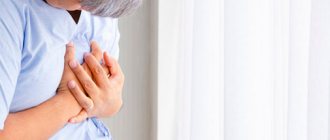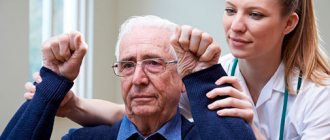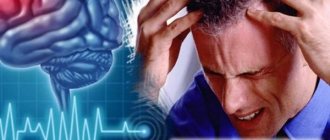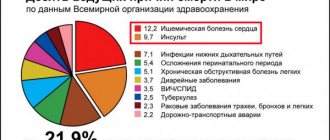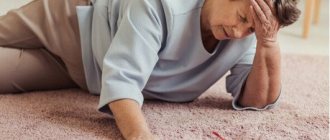August 23, 2021
A stroke is a disease in which cerebral circulation is disrupted due to a disruption in the blood supply to the brain (or spinal) cord or a rupture of a vessel. Due to an “accident”, areas of tissue in the brain are damaged or killed. This disrupts the functioning of the human body - leads to impairment of motor and cognitive functions.
There are also unique symptoms that depend on the location of the lesion in the brain. If we dive into this in detail, then, for example, with a stroke in the region of the caudate nucleus, in addition to general symptoms, a person will clearly notice mental and emotional inertia, a decrease or absence of motor activity in conversation and normal daily activities. And with a stroke in the temporoparietal region, the patient will experience psychosis and, possibly, epileptic seizures.
But these details are seen and diagnosed by specialists; for an ordinary person who has experienced a stroke, it is enough to understand the difference between a stroke of the right hemisphere and the left, and what kind of rehabilitation is needed for each of them. We will talk about this in this article.
What are the features of a right hemisphere stroke?
The right hemisphere controls the left half of the body. The same is true on the opposite side - the left side of the brain controls the right side of the body. The exception is deep unconscious sensitivity - understanding the position of the body in space. This sensitivity persists even after a stroke, since there are certain features of the transmission of this type of sensitivity to the brain.
The system of such cross-work is relevant for the physical functioning of a person, for example, if the localization of a stroke is the right hemisphere of the brain, then the person will experience paralysis (in the form of severe weakness or, conversely, high tone of the muscles of the arms and legs) of the left half of the body.
It is also important that the right side of the brain is responsible for psychological state, emotions, imagination and spatial orientation. Due to disruption of the right hemisphere, a person’s spatial thinking and understanding of objects are impaired, creative abilities are lost, and it becomes difficult to control emotions and connect the imagination.
A right hemisphere stroke is so serious that its consequences can ruin a person's life, so it is important to begin rehabilitation as soon as possible to maximize recovery.
Therapeutic exercises
To restore the motor function of the right side of the body after a left-sided stroke, physical therapy is prescribed. The main goal of health-improving gymnastics is to develop movements and improve the sensitivity of the limbs.
These are simple exercises that the patient needs to perform several times a day with a certain number of approaches. They are presented:
- clenching and unclenching your palm into a fist;
- raising your hand up in front of you and slowly lowering it;
- lifting your leg up from a lying position.
More complex gymnastics are performed together with a specialist.
Patients are also prescribed a number of breathing exercises that help get rid of shortness of breath and improve the functioning of the heart and blood vessels.
What are the features of a left hemisphere stroke?
As we said above, the left hemisphere of the brain controls the right half of the human body. If the left hemisphere of the brain is damaged, paresis (paralysis) of the right limbs will be noted.
The left hemisphere also controls speech (for all right-handers and half of left-handers, and for the other half of left-handers, the center of speech is located in the right hemisphere of the brain), memory and cognitive functions, so during a stroke the patient may have problems with speech, he will lose memory, and mood swings, behavior will change - he will become slow and cautious.
Causes
In general, the origins of any type of ischemia are similar. Risk factors include previous history of:
- atherosclerosis of the large arteries of the brain;
- diabetes;
- compaction of the vessels of the extremities;
- hemicrania;
- atrial fibrillation;
- purulent-septic diseases;
- brain vasculitis;
- arterial hypertension and so on.
A stroke can develop against the background of chronic diseases of the cardiovascular system, in particular heart defects.
The occurrence of a blood clot can be provoked by pathologies in the composition of the blood, that is, its increased viscosity.
Atherothrombotic ischemic stroke in the left MCA region occurs due to the formation of a blood clot and blockage of the vessel.
This type of disease occurs against the background of coronary heart disease or arterial hypertension.
A completely healthy woman can develop a stroke due to frequent use of contraceptives.
Excessive smoking or drinking alcohol also depresses the condition of blood vessels. The result is a massive ischemic stroke.
Outcome of right hemisphere stroke
If a stroke occurs in the right hemisphere of the brain, the consequences will affect not only the physical condition of the person, but also cause psychological, emotional and behavioral difficulties.
What to expect after a stroke on the right side? The consequences after the “blow” will be as follows:
- Hemiplegia or hemiparesis
A person will feel paralyzed on the left side after a stroke. He has paralysis and severe weakness in the limbs of the affected side.
- Unilateral spatial neglect
The patient does not perceive one side of the body when performing everyday tasks, ignores part of the left space, and even from memory can only describe the left side of an object or room.
- Loss of body control
The patient loses the ability to move his left arm, leg or smile, and the mobility of the left corner of his mouth decreases.
- Denial syndrome (a person cannot critically assess his condition)
The patient may think that he is fully functioning, despite the fact that in reality this is not the case. A person with this syndrome may become severely injured while trying to perform an activity, or may refuse to undergo rehabilitation, thinking that he is healthy.
- The problem of orientation in space
The patient cannot determine his location in the room. He may also not understand the distance from his hand to an object; this manifests itself during meals, when moving from a bed to a chair, or when changing clothes.
- Emotional Indifference
Due to changes in the emotional state, the patient may not perceive himself in new realities and behave as if nothing had happened.
- There is no way to read the hidden meaning
A person who has had a stroke may have trouble hearing certain sounds and may not be able to grasp the intonation and tone of speech. A person after a stroke does not understand humor and sarcasm.
- Lack of concentration
The patient cannot fully concentrate on the action; it takes him a long time to “gather his thoughts.” The most difficult time for a person to concentrate is when he is given instructions, asked to fulfill a request, answer questions, or solve a simple problem.
If a stroke occurs on the right side, the consequences and how long the rehabilitation will last will depend on the degree of impairment of the person’s physical and psycho-emotional functions. It also depends on when the patient will begin rehabilitation.
The ideal time for rehabilitation is the first 3 months after a stroke, and the most intensive training should be done in the first month after discharge from the hospital.
How to prolong and improve life after an ischemic stroke
The period after an ischemic attack is divided into five periods:
- The critical stage is the first 72 hours.
- Acute period – 25-30 days.
- The first stage of recovery is from 3 to 6 months.
- The second recovery period is 12–24 months.
- Residual processes – From 24 months or more.
Life expectancy after an ischemic stroke depends on numerous factors, from the size of the brain lesion to treatment measures. Providing first aid also affects the outcome of recovery; a simple rule applies here: the sooner, the better.
In the first year after ischemic hemorrhage, 65% of patients survive, after 5 years half survive, but after 10 years only a quarter remain alive.
Help to prolong life:
- correct lifestyle;
- diagnostics every 2 – 3 months;
- nutrition;
- restorative gymnastics.
Salt, sugar, fatty and flour foods, smoked meats and sauces should be excluded from the diet. The diet should be dominated by vegetables and fruits, a large amount of fiber and vegetarian soups. Meals should be fractional, 5 meals in small portions.
Timely diagnosis and physical therapy, which improves the quality of blood flow, will help prevent a recurrent attack.
Outcome of left hemisphere stroke
Along with the typical consequences of a stroke in the right hemisphere, there are also unique consequences after a “stroke” in the left hemisphere.
The consequences of a stroke in the left hemisphere of the brain are as follows:
- Hemiplegia or hemiparesis
A person will feel paralyzed on the right side after a stroke. He has paralysis and severe weakness in the limbs of the affected side.
- Aphasia - speech disorder
Because the speech center is located in the left hemisphere of the brain, a person who has had a left-sided stroke will have incoherent speech, may rearrange sounds in words, repeat words, and not understand the meaning of phrases. He may also not understand spoken speech or understand everything, but be unable to say anything.
- Apraxia of speech - difficulties in communication
Apraxia is a condition in which a person is unable to control muscles and perform normal activities. With apraxia of speech, the patient experiences difficulty moving the muscles around the mouth, which interferes with the formation of sounds and words. Although he may cognitively know what he wants to say, he cannot force his mouth to form words. Therefore, this is a motor problem, not a language problem.
- Dysphagia
The patient has impaired swallowing function
- Verbal memory impairment
The patient forgets names and cannot remember them, he is unable to retell the story he just heard, and he does not perceive and understand information well.
There are other consequences that occur after a stroke, but the disorders listed above are the most common for patients.
Recovery after a stroke of the left hemisphere takes a long time. Sometimes it is possible to return to the previous quality of life during the early rehabilitation period (the first 3 months after a stroke), and sometimes the consequences of a stroke remain with a person for the rest of his life.
The timing of the start of rehabilitation is of enormous importance; under no circumstances should rehabilitation be postponed. Recovery should begin right in the hospital. At the neurological departments of city hospitals there are exercise therapy instructors and massage therapists who are engaged in restoring the patient’s physical activity while he is in hospital.
And immediately after discharge from the hospital, the patient must be provided with home-based or outpatient (if he can move independently) rehabilitation, as well as equip the environment for the needs of the person faced with this terrible situation.
Drug therapy
Drug treatment is selected according to the form of the disease. Drugs for left hemisphere stroke of ischemic nature include the following groups:
- Thrombolytics. They are used in the first hours after a vascular accident to dissolve blood clots.
- Anticoagulants.
- Medicines that lower blood pressure.
- Neuroprotectors.
- Vasoactive drugs.
In the case of hemorrhagic stroke on the left side, vascular strengthening drugs and drugs that prevent vasospasm are used.
For both types, general medications are also provided, which include diuretics and decongestants, as well as sedatives and hypnotics. During rehabilitation, patients are also prescribed medications to treat bedsores.
Causes
- Hypertension or the appearance of a hypertensive crisis.
- Chronic forms of vasculitis.
- Consequences of long-term use of anticoagulants or other drugs that thin the blood.
- Poisoning with toxic chemicals.
- Diseases associated with insufficient blood clotting, for example, hemophilia, thrombocytopathy.
- Violation of the integrity of the vascular wall.
- Consequences of strong physical exertion.
- Consequences of traumatic brain injury.
In ischemic pathologies, the causes are:
- Atherosclerotic lesion of the vascular wall.
- The manifestation of varicose veins of the lower extremities, which is complicated by the formation of blood clots.
- Blood clots formed in the atria due to abnormal heart rhythms, for example, the result of atrial fibrillation.
- Excess body weight.
- Increased blood clotting.
- Abrupt increase in blood pressure.
- Having bad habits such as smoking, drinking alcohol, or overeating foods with high calorie content and excess cholesterol.

